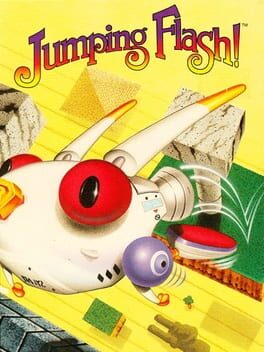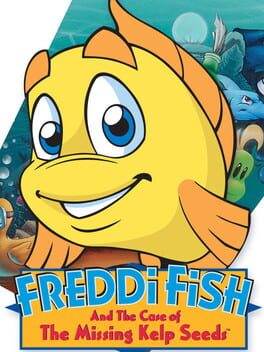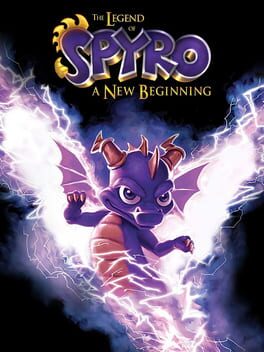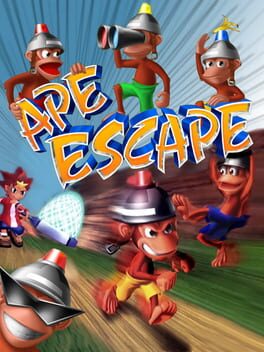Turquoisephoenix
804 Reviews liked by Turquoisephoenix
Jumping Flash!
1995
Cooking Mama
2006
Cooking Mama
2006
Tonic Trouble
1999
Why this game exists in the way it does is beyond me. I suppose there was a feeling that Spyro needed to mature and get darker and edgier to coincide with the next console generation as so many IPs did? Do they feel like a total series overhaul was necessary because of the failure of Enter The Dragonfly? Which was literally just because the game was rushed?
Either way, the end result is a limp, lifeless and dull beat-em-up of all things. Say goodbye to flying and gems and anything that made Spyro what it was, now you're gonna spend about 7 hours or so combo-ing generic looking enemies into an invisible wall.
As a kid who loved Spyro, I got this game day 1 of release and had no idea what it would be. I finished it on the day I got it, because it isn't very long, there isn't much to do in it and I guess I was compelled by morbid curiosity to see just how badly they'd massacred my boy. I didn't care much for it. It wasn't obnoxiously bad, it functioned, and the combat occasionally felt pretty satisfying but man, what a tone-deaf videogame.
In order to further establish how GROWN-UP the series is now, this game features a voice cast of famous actors, because nothing says sick nasty reboot quite like a bunch of disinterested celebrities who likely don't know what the fuck's going on in the game they've been cast in. Elijah Wood plays Spyro, Gary Oldman plays Ignitus, his mentor...and DAVID SPADE plays SPARX.
On the surface this may sound interesting at the very least, but that intrigue will fade in about an hour or so as you realise just how little of a shit any of these people give. They're no Tom Kenny, I'll say that much. They sound so bored and rambly, so incredibly disengaged from whatever's going on in the game...And really, who can blame them?
Either way, the end result is a limp, lifeless and dull beat-em-up of all things. Say goodbye to flying and gems and anything that made Spyro what it was, now you're gonna spend about 7 hours or so combo-ing generic looking enemies into an invisible wall.
As a kid who loved Spyro, I got this game day 1 of release and had no idea what it would be. I finished it on the day I got it, because it isn't very long, there isn't much to do in it and I guess I was compelled by morbid curiosity to see just how badly they'd massacred my boy. I didn't care much for it. It wasn't obnoxiously bad, it functioned, and the combat occasionally felt pretty satisfying but man, what a tone-deaf videogame.
In order to further establish how GROWN-UP the series is now, this game features a voice cast of famous actors, because nothing says sick nasty reboot quite like a bunch of disinterested celebrities who likely don't know what the fuck's going on in the game they've been cast in. Elijah Wood plays Spyro, Gary Oldman plays Ignitus, his mentor...and DAVID SPADE plays SPARX.
On the surface this may sound interesting at the very least, but that intrigue will fade in about an hour or so as you realise just how little of a shit any of these people give. They're no Tom Kenny, I'll say that much. They sound so bored and rambly, so incredibly disengaged from whatever's going on in the game...And really, who can blame them?
Tchia
2023
A lovely wee thing that gives a glimpse into a culture I never knew existed. A place named after my own country no less.
Tchia lets you just kinda mess about. Possess a bird and fly over villages. Make it do a shit. Play your uke to summon a plant that bounces you into the air, or a bubble helmet that gives you infinite breath for deep diving. Take out a camp of creatures made from fabric by controlling a plank of wood to roll through a fire and burn them all to unlock some cool sunglasses. Do the palm tree thing from Beverly Hills Ninja. It's a bit of a simple wee playground, but the playground is big.
The story surprised me because despite not being anything incredible, it's quite dark and got me a few times while also being humorous in places. You can just tell there's a lot of love here. It oozes throughout.
I understand the BOTW chat at a glance, but please don't go in expecting that. The elements it does borrow are very light indeed, and we need to stop comparing everything with grass fields and a glider to it. The "collectathon" chat can be taken with a grain of salt too, because that's completely optional, and while there are a ton of map markers, you maybe only have to search out 20 of them unless you like just exploring.
In the nicest way possible, just chill out, switch your brain off, and take control of a chicken that lays explosive eggs.
Tchia lets you just kinda mess about. Possess a bird and fly over villages. Make it do a shit. Play your uke to summon a plant that bounces you into the air, or a bubble helmet that gives you infinite breath for deep diving. Take out a camp of creatures made from fabric by controlling a plank of wood to roll through a fire and burn them all to unlock some cool sunglasses. Do the palm tree thing from Beverly Hills Ninja. It's a bit of a simple wee playground, but the playground is big.
The story surprised me because despite not being anything incredible, it's quite dark and got me a few times while also being humorous in places. You can just tell there's a lot of love here. It oozes throughout.
I understand the BOTW chat at a glance, but please don't go in expecting that. The elements it does borrow are very light indeed, and we need to stop comparing everything with grass fields and a glider to it. The "collectathon" chat can be taken with a grain of salt too, because that's completely optional, and while there are a ton of map markers, you maybe only have to search out 20 of them unless you like just exploring.
In the nicest way possible, just chill out, switch your brain off, and take control of a chicken that lays explosive eggs.
Tchia
2023
I've played many games with better gameplay, better mechanics, and better writing, but I have rarely played a game that exudes as much joy and passion for its subject matter as Tchia. This game is everything that it sets out to be: a love letter to New Caledonia, making it a joy to play, despite its underwhelming mechanics
Tchia
2023
The finest art direction of any fantasy game: trippy but seamlessly so, like it all came together the only way it could. WoW's clunky physicality just pops with warped perspectives and spaces that seem to expand beyond the game container, cued exactly for when it knows you're breathless. The Fel Reaver, a giant that wanders the doom metal concept art of Hellfire Peninsula, is an all-timer. At a distance it moves with the eerie grace of one of Team Ico's colossi, evoking a similar loneliness (just here, it wanders eternally in space). But to forget about the Fell Reaver is to have the ground tremble and everybody else flee, and to have that inhuman loneliness shot through with fear of that which is beyond oneself. The Fel Reaver has a heart, but it does not beat for us. I wonder what it is looking for?
Ape Escape
1999
Ape Escape
1999
I could, and did (on an episode of Retronauts), speak at length about Ape Escape and each aspect of its being but I want to focus on controls here.
Much ink has been spilled in reverie of Super Mario 64's influence on 3D gaming. It rests on a pedestal so as to always invite comparison, hailed as "the new gold standard in video games" since its release.¹ The notion that Super Mario 64 was "the first [game] to get the control scheme right" in the 3D platformer space is evident by that separation of player movement and camera movement across the gaming landscape today.² With how infrequently - which is to say, not all of the time - the player moves the camera in Super Mario 64, the relegation of the camera to a quartet of readily accessible buttons is puzzling but forgivable for such an early True 3D Platformer.
The most critical part of Super Mario 64's legacy is its insistence on player control in a 3D space being simple and streamlined; push forward to go forward, press A to jump, no faffing about. As seen with early 2010s titles like Octodad or Surgeon Simulator, requiring players to engage in more direct, less conventional control schemes is a 'meme,' some source of comedy in large part because those controls are in direct defiance of reiterated means of control in gaming. While neither title nor their contemporaries illustrate with clarity the benefit of these subversive control methods, Ape Escape did over a decade earlier.
As the first PlayStation game to necessitate use of the DualShock controller, Japan Studio sought to use its features maximally from the ground up due to its potential as a dual analog device.³ The use of the second dog-nose textured stick for gameplay and direct character action was one of the only marked control innovations in the 3D platformer space since Super Mario 64. Demo discs espoused the DualShock and its implementation in Ape Escape as a tool one needed to master alongside the gameplay itself. Contemporary reviews corroborated these claims in large part because Ape Escape's controls refused the immediacy of Mario, Spyro, Banjo-Kazooie, and Crash. Jumping could happen with the tap of a button but gadgets were not so simple, yet they were even more intuitive because of the DualShock's second analog stick.
The Stun Club and Time Net are swung by moving the right analog stick towards your target, or spun through a full rotation. The Monkey Radar similarly is aimed in any direction to highlight the location of monkeys. This trio of tools is served to the player first because their input and action are direct -- you point the stick where you want the thing to happen, just as you do with the left stick for movement.
The Slingback Shooter presents the first deviation from what one might expect - rather than move the stick towards the target the player instead moves it away from the target as if operating an actual slingshot, releasing to fire. This movement is tactile thanks to the re-centring of the stick, snapping back with speed like taut elastic released. The Dash Hoop and Sky Flyer both require full, repeated rotations of the stick to simulate the movement, the latter mimicking a propeller around an axle, the former acting not as the hula hoop itself moving around the player but the player's hips working to get the hoop up to speed.
The final gadget (not including the post-game Magic Punch), the R.C. Car, is the most abstracted from convention as the second analog stick directly moves the vehicle separate from the player, likened by Tim Rogers to the dual arrows of Namco's 1983 game Libble Rabble.⁴ The comparison is apt on a surface level but while Libble Rabble requires simultaneous movement of Libble and Rabble to achieve the player goal of harvesting Mushlins, Ape Escape's R.C. Car is primarily maneuvered independently of the player in short bursts while the player adjusts their view or, more likely, stands still to focus solely on the R.C. Car. The player can, of course, move all they want while using the R.C. Car but this is not required because of Ape Escape's focus on oneness of control instead of separation of function and movement.
The Monkey Radar and R.C. Car notwithstanding, every gadget in Ape Escape complements movement in a similar manner to Mario's moveset in any of his 3D romps but with an added layer of immersion and intent. Chasing a monkey is not just a matter of platforming one's way toward an object through movement. The player needs to use the gadgets for their approach and for the act of catching the monkey, be it by hitting it with the Stun Club or Slingback Shooter, or just through aiming the Time Net towards an often moving target. The evasive maneuvers used by the monkeys heightens the pursuit further. If a monkey dives away from the Time Net the player can flick the stick towards its new location or perhaps keep the analog stick tilted and rotate it to catch the monkey in a spin. If a monkey is airborne the player can get near and shoot them down with the Slingback Shooter, or use the Sky Flyer to ascend to their level then quickly swap to the Time Net and catch them while you fall. Some monkeys require silver bullet solutions but player freedom is abundant across Ape Escape.
One of the greatest challenges of Ape Escape and enjoying it is that one has to meet it on its own terms. Just like one can't go into Gunstar Heroes expecting it to be like Contra, the prospective player cannot go into Ape Escape with the expectation it will control like or even resemble Super Mario 64. Just like the aforementioned piece of Treasure developed software, Ape Escape defies a reading which compares it to that which it is aesthetically associated with.
A few years back I came across an article which lambasted Ape Escape's controls following an authorial statement "to assess [old] games as if they were released today, not as products of the times in which they were created."⁵ Merits and flaws of such an approach aside, this umbrage with Ape Escape's convention-eschewing control scheme suggests that breaking from the Super Mario 64 style of platforming is itself heretical. Mention is made of the difficulty of rapidly adjusting the camera which were moved to the D-Pad and L1, something allegedly taken for granted presently whereas in 1999 there was "no well of experience to draw on" for this predicament.⁶ Ignoring the fact that 3D platformers had already contended with camera movement through the N64's C Buttons, effectively an analog to the DualShock's right analog stick, this perspective ignores Ape Escape's own camera concessions and means of manipulation. Ape Escape's levels are generally large enough to not require camera movement, and when the camera does need adjusting the L1 button immediately snaps the camera behind Spike, just as the R button did in Banjo-Kazooie. More direct control of the camera via the D-Pad is indeed more tedious and cumbersome but it is also in effect unnecessary by virtue of those expansive spaces. The article similarly raises qualms with the use of gadgets, considering the use of gadgets while moving to be analogous to patting one's head and rubbing one's tummy. This anapodoton that Ape Escape's controls equate to being poor is by no means unique to the article, and as a punchline it seems willfully ignorant of what Ape Escape expects of the player and their ability to adopt its way of thinking about control.⁷ Ultimately the article stands as the apex of decades of whinging about Ape Escape's perceived awkwardness, and the claims from those scant few who consider a suitable alternative to be pushing a button to engage in an action, akin to Mario punching. This is especially curious as Ape Escape got a port which 'remedied' this exact problem with 2005's Ape Escape: On the Loose.
The absence of a second analog nubbin on the PlayStation Portable saw gadgets being used through buttons, snatching from the player the degree of freedom in action the original release had. More critically, however, this digital interpretation of once analog intentions widens the gap between the player's actions and the actions of the character. The aforementioned oneness of Ape Escape is fundamental to the play experience because the title was developed for the DualShock, not around it or in spite of it. The placelessness of Super Mario 64 or Banjo-Kazooie or Spyro or any other 3D platformer which sees them effortlessly ported to new hardware with vastly different methods of control when compared to their original hardware is of value for those games, but it also demonstrates with crystal clarity that their universality opposes innovation vis-a-vis interaction with a game in a physical way. Contrastingly, Ape Escape occupies a position unique to and necessitated by the DualShock, evoking a sort of critical regionalism for games. In a similar vein to Alvar Aalto or Luis Barragán, both of whom have seen their architectonics (re)iterated outside of Finland and Mexico so as to suggest their forms exist and flourish outside their specific constraints and qualities of space and place, Ape Escape's ability to be placed outside of the PlayStation, with controllers that are not the DualShock (but resemble its form through four shoulder buttons and two analog sticks) should not be construed as it being separate from the DualShock.
In less grandiose terms, Ape Escape is the DualShock. Ape Escape deliberately avoided grafting camera controls to the second analog stick in favour of something more nuanced yet more natural and intuitive. Super Mario 64, the supposed pinnacle of 3D platforming and 'perfect' camera controls, is not the Nintendo 64 controller -- Miyamoto himself allegedly did not even like the C Buttons, and the game was designed using modified Sega gamepads for much of its development.⁸ Yet both can be and are played on newer hardware with controllers not of their era without being worse for the wear, if only because the DualShock and its dual analog sticks became the norm, the second stick functioning as a decent simulacrum for the solution of C Button cameras. And when Super Mario 64 got its portable port on the Nintendo DS, it was no worse for wear because the lack of C Buttons did not equate to a drastic change in gameplay. What is seen as awkward to some is precisely what makes Ape Escape work, and what made it so captivating to players in its own time, and still is today. That perfect implementation of a novel control scheme demonstrates to us a world of gaming that could have been; perhaps what should have been.
____________________
¹ "The Fun Machine: An Exclusive World Tour of the First Nintendo 64 Games," Nintendo Power 85, June 1996, 16.
² "Countdown to 200: The 10 Most Important Games," Electronic Gaming Monthly 187, January 2005.
³ "Ape Escape," PlayStation Underground 3, 1999.
⁴ Tim Rogers, "ACTION BUTTON REVIEWS PAC-MAN," YouTube video, 2:55:58, November 22, 2020.
⁵ Patrick Arthur, "Ape Escape and the Things We Take for Granted," Retro Spectives Podcast, March 31, 2019, https://www.rspodcast.net/articles/ape-escape-and-the-things-we-take-for-granted.
⁶ Ibid.
⁷ https://www.twitch.tv/protonjon/clip/LitigiousExcitedWrenDendiFace-uWmxCn2TR-f5klsO?filter=clips&range=7d&sort=time
⁸ "The Making of Mario 64: Giles Goddard Interview," NGC Magazine 61, December 2001.
Much ink has been spilled in reverie of Super Mario 64's influence on 3D gaming. It rests on a pedestal so as to always invite comparison, hailed as "the new gold standard in video games" since its release.¹ The notion that Super Mario 64 was "the first [game] to get the control scheme right" in the 3D platformer space is evident by that separation of player movement and camera movement across the gaming landscape today.² With how infrequently - which is to say, not all of the time - the player moves the camera in Super Mario 64, the relegation of the camera to a quartet of readily accessible buttons is puzzling but forgivable for such an early True 3D Platformer.
The most critical part of Super Mario 64's legacy is its insistence on player control in a 3D space being simple and streamlined; push forward to go forward, press A to jump, no faffing about. As seen with early 2010s titles like Octodad or Surgeon Simulator, requiring players to engage in more direct, less conventional control schemes is a 'meme,' some source of comedy in large part because those controls are in direct defiance of reiterated means of control in gaming. While neither title nor their contemporaries illustrate with clarity the benefit of these subversive control methods, Ape Escape did over a decade earlier.
As the first PlayStation game to necessitate use of the DualShock controller, Japan Studio sought to use its features maximally from the ground up due to its potential as a dual analog device.³ The use of the second dog-nose textured stick for gameplay and direct character action was one of the only marked control innovations in the 3D platformer space since Super Mario 64. Demo discs espoused the DualShock and its implementation in Ape Escape as a tool one needed to master alongside the gameplay itself. Contemporary reviews corroborated these claims in large part because Ape Escape's controls refused the immediacy of Mario, Spyro, Banjo-Kazooie, and Crash. Jumping could happen with the tap of a button but gadgets were not so simple, yet they were even more intuitive because of the DualShock's second analog stick.
The Stun Club and Time Net are swung by moving the right analog stick towards your target, or spun through a full rotation. The Monkey Radar similarly is aimed in any direction to highlight the location of monkeys. This trio of tools is served to the player first because their input and action are direct -- you point the stick where you want the thing to happen, just as you do with the left stick for movement.
The Slingback Shooter presents the first deviation from what one might expect - rather than move the stick towards the target the player instead moves it away from the target as if operating an actual slingshot, releasing to fire. This movement is tactile thanks to the re-centring of the stick, snapping back with speed like taut elastic released. The Dash Hoop and Sky Flyer both require full, repeated rotations of the stick to simulate the movement, the latter mimicking a propeller around an axle, the former acting not as the hula hoop itself moving around the player but the player's hips working to get the hoop up to speed.
The final gadget (not including the post-game Magic Punch), the R.C. Car, is the most abstracted from convention as the second analog stick directly moves the vehicle separate from the player, likened by Tim Rogers to the dual arrows of Namco's 1983 game Libble Rabble.⁴ The comparison is apt on a surface level but while Libble Rabble requires simultaneous movement of Libble and Rabble to achieve the player goal of harvesting Mushlins, Ape Escape's R.C. Car is primarily maneuvered independently of the player in short bursts while the player adjusts their view or, more likely, stands still to focus solely on the R.C. Car. The player can, of course, move all they want while using the R.C. Car but this is not required because of Ape Escape's focus on oneness of control instead of separation of function and movement.
The Monkey Radar and R.C. Car notwithstanding, every gadget in Ape Escape complements movement in a similar manner to Mario's moveset in any of his 3D romps but with an added layer of immersion and intent. Chasing a monkey is not just a matter of platforming one's way toward an object through movement. The player needs to use the gadgets for their approach and for the act of catching the monkey, be it by hitting it with the Stun Club or Slingback Shooter, or just through aiming the Time Net towards an often moving target. The evasive maneuvers used by the monkeys heightens the pursuit further. If a monkey dives away from the Time Net the player can flick the stick towards its new location or perhaps keep the analog stick tilted and rotate it to catch the monkey in a spin. If a monkey is airborne the player can get near and shoot them down with the Slingback Shooter, or use the Sky Flyer to ascend to their level then quickly swap to the Time Net and catch them while you fall. Some monkeys require silver bullet solutions but player freedom is abundant across Ape Escape.
One of the greatest challenges of Ape Escape and enjoying it is that one has to meet it on its own terms. Just like one can't go into Gunstar Heroes expecting it to be like Contra, the prospective player cannot go into Ape Escape with the expectation it will control like or even resemble Super Mario 64. Just like the aforementioned piece of Treasure developed software, Ape Escape defies a reading which compares it to that which it is aesthetically associated with.
A few years back I came across an article which lambasted Ape Escape's controls following an authorial statement "to assess [old] games as if they were released today, not as products of the times in which they were created."⁵ Merits and flaws of such an approach aside, this umbrage with Ape Escape's convention-eschewing control scheme suggests that breaking from the Super Mario 64 style of platforming is itself heretical. Mention is made of the difficulty of rapidly adjusting the camera which were moved to the D-Pad and L1, something allegedly taken for granted presently whereas in 1999 there was "no well of experience to draw on" for this predicament.⁶ Ignoring the fact that 3D platformers had already contended with camera movement through the N64's C Buttons, effectively an analog to the DualShock's right analog stick, this perspective ignores Ape Escape's own camera concessions and means of manipulation. Ape Escape's levels are generally large enough to not require camera movement, and when the camera does need adjusting the L1 button immediately snaps the camera behind Spike, just as the R button did in Banjo-Kazooie. More direct control of the camera via the D-Pad is indeed more tedious and cumbersome but it is also in effect unnecessary by virtue of those expansive spaces. The article similarly raises qualms with the use of gadgets, considering the use of gadgets while moving to be analogous to patting one's head and rubbing one's tummy. This anapodoton that Ape Escape's controls equate to being poor is by no means unique to the article, and as a punchline it seems willfully ignorant of what Ape Escape expects of the player and their ability to adopt its way of thinking about control.⁷ Ultimately the article stands as the apex of decades of whinging about Ape Escape's perceived awkwardness, and the claims from those scant few who consider a suitable alternative to be pushing a button to engage in an action, akin to Mario punching. This is especially curious as Ape Escape got a port which 'remedied' this exact problem with 2005's Ape Escape: On the Loose.
The absence of a second analog nubbin on the PlayStation Portable saw gadgets being used through buttons, snatching from the player the degree of freedom in action the original release had. More critically, however, this digital interpretation of once analog intentions widens the gap between the player's actions and the actions of the character. The aforementioned oneness of Ape Escape is fundamental to the play experience because the title was developed for the DualShock, not around it or in spite of it. The placelessness of Super Mario 64 or Banjo-Kazooie or Spyro or any other 3D platformer which sees them effortlessly ported to new hardware with vastly different methods of control when compared to their original hardware is of value for those games, but it also demonstrates with crystal clarity that their universality opposes innovation vis-a-vis interaction with a game in a physical way. Contrastingly, Ape Escape occupies a position unique to and necessitated by the DualShock, evoking a sort of critical regionalism for games. In a similar vein to Alvar Aalto or Luis Barragán, both of whom have seen their architectonics (re)iterated outside of Finland and Mexico so as to suggest their forms exist and flourish outside their specific constraints and qualities of space and place, Ape Escape's ability to be placed outside of the PlayStation, with controllers that are not the DualShock (but resemble its form through four shoulder buttons and two analog sticks) should not be construed as it being separate from the DualShock.
In less grandiose terms, Ape Escape is the DualShock. Ape Escape deliberately avoided grafting camera controls to the second analog stick in favour of something more nuanced yet more natural and intuitive. Super Mario 64, the supposed pinnacle of 3D platforming and 'perfect' camera controls, is not the Nintendo 64 controller -- Miyamoto himself allegedly did not even like the C Buttons, and the game was designed using modified Sega gamepads for much of its development.⁸ Yet both can be and are played on newer hardware with controllers not of their era without being worse for the wear, if only because the DualShock and its dual analog sticks became the norm, the second stick functioning as a decent simulacrum for the solution of C Button cameras. And when Super Mario 64 got its portable port on the Nintendo DS, it was no worse for wear because the lack of C Buttons did not equate to a drastic change in gameplay. What is seen as awkward to some is precisely what makes Ape Escape work, and what made it so captivating to players in its own time, and still is today. That perfect implementation of a novel control scheme demonstrates to us a world of gaming that could have been; perhaps what should have been.
____________________
¹ "The Fun Machine: An Exclusive World Tour of the First Nintendo 64 Games," Nintendo Power 85, June 1996, 16.
² "Countdown to 200: The 10 Most Important Games," Electronic Gaming Monthly 187, January 2005.
³ "Ape Escape," PlayStation Underground 3, 1999.
⁴ Tim Rogers, "ACTION BUTTON REVIEWS PAC-MAN," YouTube video, 2:55:58, November 22, 2020.
⁵ Patrick Arthur, "Ape Escape and the Things We Take for Granted," Retro Spectives Podcast, March 31, 2019, https://www.rspodcast.net/articles/ape-escape-and-the-things-we-take-for-granted.
⁶ Ibid.
⁷ https://www.twitch.tv/protonjon/clip/LitigiousExcitedWrenDendiFace-uWmxCn2TR-f5klsO?filter=clips&range=7d&sort=time
⁸ "The Making of Mario 64: Giles Goddard Interview," NGC Magazine 61, December 2001.
Ape Escape
1999
Ape Escape
1999
Ape Escape
1999
How different games might be if we didn’t have it in our heads that the right stick must be for camera control. Part of the fun of early 3D games is how little about them was standardised. Jump between any given two of them and there’s a decent chance that few, if any, of the skills or habits you develop in one will translate to another. The lengths a unique control scheme goes toward accentuating this sort of variety and distinctiveness probably goes without saying, but Ape Escape also makes a similarly strong case for how much more intuitive it can be.
Being able to swing a doodad in any direction you want with a simple tilt of the stick, no matter your positioning or which way you’re facing, feels so natural it’s unreal. It’s the type of seemingly mundane thing you don’t realise is so rare in games until you first encounter it and, given how erratically the monkeys move upon being alerted, comes in so handy I can’t imagine the game controlling any other way. That would already be worthy of enough praise as is, but the game’s bolstered even further by how the gadgets get more creative as it goes on.
The RC car is a particular standout. Few platformers will get your proverbial gears turning as much as guiding both Spike and the RC car through two different sets of moving obstacle courses at the same time. It’s really, really striking how similar the car feels to some action games of recent years in which controlling multiple characters has become increasingly common – if there was ever a context where “ahead of its time” was 100% appropriate to use, this is it, though Ecclesiastes 1:9 also comes to mind.
Don’t let the revelation that Astral Chain is secretly an Ape Escape sequel distract you from how remarkably forward thinking other aspects of this game are, though. Past a certain point, platforming sequences will demand you quickly rotate between several gadgets in quick succession to get to the monkey on the other side, but this is a totally fluid experience thanks to how you can instantly switch between gadgets with the face buttons. You can even go straight to the equipment menu without having to go through the pause menu first if you’d like to quickly swap out your current gadgets. Excessive menuing plagues many a game even now, to say nothing of how this could easily have been compounded by memory limitations of the day, which makes it all the more impressive how effortlessly Ape Escape almost completely circumvents that issue.
The water net and the (very few) tank segments are more finicky, but some misses here and there are to be expected when you’re tackling such an ambitious range of level concepts. When you’re rigorously working your way through precision platforming segments in a castle floating in Earth’s orbit at the end, it’s easy to forget that this is the same game in which you were sniping monkeys with a slingshot inside the belly of a dinosaur just a few hours ago.
Beyond using the time travelling premise to the fullest, the levels – and the game as a whole – are great at letting you progress at your own pace. Only half of all the monkeys in the game are required to catch to get to the end, so it feels very much like a precursor to the Jak & Daxter school of “don’t like it, don’t do it.” This freedom’s aided by the levels’ complexity and nonlinearity, especially those later on in the game, full of optional rooms packed with unique challenges you’re not likely to see anywhere else. Because of this, there’s also plenty of incentive to revisit previous levels with gadgets you didn’t initially have, a bit akin to one of those veinytroids or whatever they’re called.
Do that and you’ll eventually unlock a bunch of minigames that’re a fair bit more interesting than they have any right to be, again thanks to the unique use of the right stick. I found it hard to not walk away from them wishing that we could get a fully fledged monkey-centric boxing or ski racing game that simulates those even more closely, until I remembered that Japan Studio (pbuh) went kaput and the concept of fun was forever cancelled as a result.
Tempting as it is to mourn them, the same infectious charm that courses through everything else they worked on is present in Ape Escape in spades, which helps cast it in a more celebratory light. I can’t imagine the Sony of today greenlighting a game this outlandish visually, tonally and mechanically any time soon, but at least they did once. Somewhere, sometime, someone at Sony decided we needed a sci-fi monkey hunting simulator which happens to feature the world’s finest turn of the century drum ‘n’ bass album as its soundtrack, and I’m delighted not just because we've gotten some fantastic games out of that, but also because this shows that somebody out there truly understands my needs.
When it’s all said and done, Ape Escape is as fun as a barrel of... you know.
Being able to swing a doodad in any direction you want with a simple tilt of the stick, no matter your positioning or which way you’re facing, feels so natural it’s unreal. It’s the type of seemingly mundane thing you don’t realise is so rare in games until you first encounter it and, given how erratically the monkeys move upon being alerted, comes in so handy I can’t imagine the game controlling any other way. That would already be worthy of enough praise as is, but the game’s bolstered even further by how the gadgets get more creative as it goes on.
The RC car is a particular standout. Few platformers will get your proverbial gears turning as much as guiding both Spike and the RC car through two different sets of moving obstacle courses at the same time. It’s really, really striking how similar the car feels to some action games of recent years in which controlling multiple characters has become increasingly common – if there was ever a context where “ahead of its time” was 100% appropriate to use, this is it, though Ecclesiastes 1:9 also comes to mind.
Don’t let the revelation that Astral Chain is secretly an Ape Escape sequel distract you from how remarkably forward thinking other aspects of this game are, though. Past a certain point, platforming sequences will demand you quickly rotate between several gadgets in quick succession to get to the monkey on the other side, but this is a totally fluid experience thanks to how you can instantly switch between gadgets with the face buttons. You can even go straight to the equipment menu without having to go through the pause menu first if you’d like to quickly swap out your current gadgets. Excessive menuing plagues many a game even now, to say nothing of how this could easily have been compounded by memory limitations of the day, which makes it all the more impressive how effortlessly Ape Escape almost completely circumvents that issue.
The water net and the (very few) tank segments are more finicky, but some misses here and there are to be expected when you’re tackling such an ambitious range of level concepts. When you’re rigorously working your way through precision platforming segments in a castle floating in Earth’s orbit at the end, it’s easy to forget that this is the same game in which you were sniping monkeys with a slingshot inside the belly of a dinosaur just a few hours ago.
Beyond using the time travelling premise to the fullest, the levels – and the game as a whole – are great at letting you progress at your own pace. Only half of all the monkeys in the game are required to catch to get to the end, so it feels very much like a precursor to the Jak & Daxter school of “don’t like it, don’t do it.” This freedom’s aided by the levels’ complexity and nonlinearity, especially those later on in the game, full of optional rooms packed with unique challenges you’re not likely to see anywhere else. Because of this, there’s also plenty of incentive to revisit previous levels with gadgets you didn’t initially have, a bit akin to one of those veinytroids or whatever they’re called.
Do that and you’ll eventually unlock a bunch of minigames that’re a fair bit more interesting than they have any right to be, again thanks to the unique use of the right stick. I found it hard to not walk away from them wishing that we could get a fully fledged monkey-centric boxing or ski racing game that simulates those even more closely, until I remembered that Japan Studio (pbuh) went kaput and the concept of fun was forever cancelled as a result.
Tempting as it is to mourn them, the same infectious charm that courses through everything else they worked on is present in Ape Escape in spades, which helps cast it in a more celebratory light. I can’t imagine the Sony of today greenlighting a game this outlandish visually, tonally and mechanically any time soon, but at least they did once. Somewhere, sometime, someone at Sony decided we needed a sci-fi monkey hunting simulator which happens to feature the world’s finest turn of the century drum ‘n’ bass album as its soundtrack, and I’m delighted not just because we've gotten some fantastic games out of that, but also because this shows that somebody out there truly understands my needs.
When it’s all said and done, Ape Escape is as fun as a barrel of... you know.







